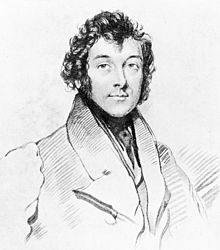Goldsworthy Gurney
Sir Goldsworthy Gurney (born February 14, 1793 in Treator near Padstow , Cornwall , † February 28, 1875 in House Reeds near Bude , Cornwall) was a British inventor and amateur scientist of the Victorian era . He worked as a surgeon , chemist , lecturer , consultant , architect and designer .
His many merits include the oxygen-hydrogen cutting torch , which he later developed into new lighting, the Bude-Licht, a very bright gas lamp, named after his place of residence Bude . He also built an early form of steam-powered road vehicles and invented the blowpipe (SteamJet) , a key component for the success of steam locomotives, machinery and other coal-fired plants. Gurney SteamJet -Erfindung to Stevenson's locomotive The Rocket (dt. The rocket) have given the speed that made him the Rainhill race was won 1829th
In 1863, Gurney was promoted to Knight Bachelor by Queen Victoria .
Gurney's steam car

From 1825 to 1829 Gurney built several steam-powered road vehicles ( steam buses ). His intention was to start a transportation business, the Gurney Steam Carriage Company . The cars were built in his factory in Regent's Park and reached a speed of 32 km / h.
One of his vehicles made a long journey from London to Bath in July 1829, two months before the Rainhill race , and reached an average speed of 22 km / h. The steam craft were not economically successful due to various difficulties and Gurney went bankrupt with large debts. Various circumstances surrounding this failure of his company led to polarizing controversies.
Other inventions and achievements
- He invented an oxygen-hydrogen cutting torch. Usually this invention is attributed to the chemist Robert Hare .
- Gurney worked in 1822 with an ammonia machine with which he drove a locomotive.
- In 1856 he patented a furnace, the Gurney Stove, for heating buildings. They are still in use today in several English cathedrals.
- He improved the lighting of theaters with his booth light, a gas light.
- From 1852 he installed the gas light, heating and ventilation in the House of Parliament in Westminster.
- He built lamps for lighthouses, steam engines, electric telegraphs and musical instruments, including a piano.
- He smothered the fire in a mine that had been burning for 30 years with a mixture of nitrogen and carbon dioxide.
His daughter Anna Jane later ran extraordinary campaigns to get the blowgun and other items recognized as his invention.
Works
- Lectures on the Elements of Chemical Science
literature
- Gurney's steam car . In: Das Auslands, 1828, No. 11 and 12, pp. 41–43 (available online at Wikisource )
- Dale H. Porter: The Life and Times of Sir Goldsworthy Gurney, Gentleman Scientist and Inventor, 1793-1875. Lehigh University Press, Bethlehem, PA 1988, ISBN 0-934223-50-5 . Introduction on the publisher's website.
- B. Dudley stamp: Bude's Forgotten Genius - Sir Goldsworthy Gurney . Bude-Stratton Town Council, Bude-Stratton Museum 1993
- George Barnett Smith: Gurney, Goldsworthy . In: Leslie Stephen, Sidney Lee (Eds.): Dictionary of National Biography . Volume 23: Gray - Haighton. MacMillan & Co, Smith, Elder & Co., New York City / London, 1890, pp 358 - 360 (English).
- George Barnett Smith: Gurney, Sir Goldsworthy (1793-1875). In: Henry Colin Gray Matthew, Brian Harrison (Eds.): Oxford Dictionary of National Biography , from the earliest times to the year 2000 (ODNB). Oxford University Press, Oxford 2004, ISBN 0-19-861411-X , ( oxforddnb.com license required ), as of 2004
- William T. Jackman: The Development of Transportation in Modern England , 1962, p. 331, ISBN 0714613266 ( online at Google Books )
Web links
- Sir Goldsworthy Gurney. Website of The Building Engineering Services Heritage Group (English)
- New Steam Carriage. In: The Mirror of Literature, Amusement, and Instruction. Vol. 10, No. 287, December 15, 1827, Project Gutenberg (English)
- Iron Horse of Fable? Articles about Gurney's Steam drag from the Steam Car Club of Britain (English)
- Mr. Goldsworthy Gurney's case - details of the select committee inquiry [1835] ( Memento of September 29, 2007 in the Internet Archive ). British Official Publications Collaborative Reader Information Service (English)
- Sir Goldsworthy Gurney. Biography at the University of Houston (English)
- Sir Goldsworthy Gurney, 1793-1875. TheMagicOfCornwall.com (English)
Individual evidence
- ↑ Dr. Andrew Ure: About the booth light. In: Polytechnisches Journal . 85, 1842, pp. 283-286.
| personal data | |
|---|---|
| SURNAME | Gurney, Goldsworthy |
| ALTERNATIVE NAMES | Gurney, Sir Goldsworthy |
| BRIEF DESCRIPTION | British surgeon, chemist, lecturer, consultant, architect, designer, inventor and amateur scientist during the Victorian Age |
| DATE OF BIRTH | February 14, 1793 |
| PLACE OF BIRTH | Treator at Padstow , Cornwall , England |
| DATE OF DEATH | February 28, 1875 |
| Place of death | House Reeds at Bude , Cornwall |


